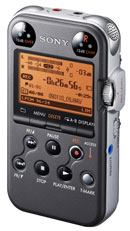
Guitar Music PageThis page includes various songs that I've written over the years as well as some live recorded performances and home-studio recordings. There are also other various sections related to my 20 year history of playing the guitar and collecting stringed instruments. Each section is chronological, with the most recent posted at the top of the page. My history as a guitarist spans covers a much wider spectrum than indicated on this page.New Classical Guitar InstrumentalsI've written about a dozen new classical guitar instrumentals over the past several months. I still need much more practice and some additional tweaking for many of the songs that I've written. However, there are quite a few that I can play pretty well but still struggle at times when it comes to performing live and/or recording at home because I tend to be easily distracted, lose focus, and then get nervous which either causes me to lose tempo or miss a note or two. In either case (live or studio) I have to play the entire song from start to finish (no cutting/splicing) which can be difficult to do without error but I am improving.My recording setup is quite simple. I have an M-Audio Delta 1010LT soundcard which allows me to record several tracks in parallel and adjust them independently. I use a Behringer XENYX1222FX mixer mostly as a mic-preamp. I record my classical guitar (or any acoustic guitar) with a pair of stereo condenser mics (Behringer C2 that I got on clearance) with one mic located near the 12th fret and the other located near the bridge. I experimented a while back with different configurations, like XY, but found that I preferred the sound of the 12/bridge configuration. I've been using a very old version of Cool Edit Pro for years which seems to work very well for me. I'll typically use Cool Edit Pro to add some reverb to the recording which makes it sound much less "dry". I'll sometimes equalize the raw recording if I feel that it is necessary, but have found that my classical guitar has such a deep, full sound that it isn't required. For the recordings below I didn't use any equalization but added a slight bit of reverb (a custom configuration). While the recordings are still short of flawless, I am very happy with the sound quality from the standpoint of an audiophile. Perhaps with a bit more patience, pratice and persistance my performance of these songs will improve, both in the home studio and live environments. The first song was recorded in one take while it took three or four takes for the second instrumental. While I've contemplated a few different names for each, I still haven't settled on a final name for either and would appreciate any suggestions based on your reaction to each. Classical Instrumenal 1 (RJB original) - Roman (classical guitar) [320kbit/s mp3 - 6MB] Classical Instrumenal 2 (RJB original) - Roman (classical guitar) [320kbit/s mp3 - 4MB] Let me know what you think. I always appreciate constructive criticism as well as input from different perspectives in order to help me determine how I can improve my current songs as well as help me diversify my writing style. My email address can be found under the About Me section. Open Mic at Shamballa Cafe 2010 (Baldwinsville NY)Shamballa's WebsiteI've been scoping out the local "open mic" scene here in Syracuse NY lately in search of places to play some of my songs. I tend to prefer performing at coffee houses as opposed to bars because people tend to pay more attention to your music and most of my classical guitar instrumental songs are better suited to that environment. I have performed at a few bars in the past but I am better suited playing bass guitar or lead guitar along with another musician in that environment (and I sometimes prefer that role because it takes a great amount of concentration and skill to play the fingerpicking instrumental songs that I've written for my classical guitar).
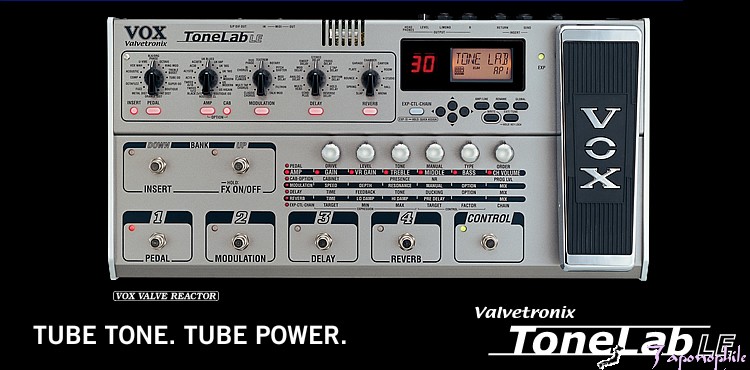
Sample Recordings: Shamballa Cafe Open Mic - Thursday Feb. 11, 2010I selected two different songs to share from this past week's open mic night event. For this week's performance I decided to experiment a bit and brought along my Vox Tonelab LE (see pic above) mulit-effects pedal board partially because it has an onboard tuner and partially to experiment with different sounds when playing my classical guitar (I had used it exclusively for my electric guitar up to this point). In hindsight I probably should have chosen an effect that only adds a bit of reverb to the sound but instead the effect that I used also added a stereo chorus type of sound to my guitar so it doesn't quite sound like a classical guitar anymore although the result is still interesting. As far as the sound quality goes, the recordings aren't that bad with the only major issues being occasional bass resonances, ambient sounds and slightly mismatched levels (most of those issues are related to the PA system and mixer settings).Look Ahead (RJB original) - Roman (classical guitar) [192kbit/s mp3 - 4MB] Look ahead is a song that I've been working on for the past few months and can be considered my most recent "complete" song (I tend to come up with many song ideas and melodies which tend to be too short to comprise a complete song). This version is still short of flawless and there are a few sections that I may work on but in general I'm pretty happy with how it sounds. I do tend to have a bad habit of playing songs too fast in public and while this version is still slightly faster than I would have liked, at least it isn't as bad as some of the "warp speed" versions that I've played in the past. Carpet Crawlers (Genesis) - Emmet (vocals/acoustic guitar), Roman (classical lead guitar) [192kbit/s mp3 - 7MB] Emmet and I were discussing Genesis songs a few weeks ago and he mentioned that "Carpet Crawlers" was on of his favorites and that he really liked the dynamics in how the song progressed and built up. Last week Emmet played it for the first time and I improvised some lead melodies but it was much more random than what I composed/played this week. The song is far from flawless and still could use some work (or at least some practice for both of us) but I'm very happy with the result considering how little time and effort was put into it and how little practice we've had with the song. Classical Guitar InstrumentalsThe only classical guitar that I've ever owned is one that I built while I was in High School back in 1991. It was made for an event in the Science Olympiad which I was a part of that year. Our team won the regional and state events and ended up taking third in the nation. My specialty that year was building balsa wood bridges and my bridge took third in the nation. So I started playing classical guitar around that time and that guitar still gets more use than the rest of mine combined probably because I really like to fingerpick and the nylon strings are easy on my fingers.Over the past 5 years or so I've been playing my solo instrumental songs at coffee houses from time to time. The problem is that my favorite local coffee house became a parking lot last year but there are still other nice places to play. My guitar teacher, Victor Lopez (his site can be found on my home page), plays at one of the local coffeehouses weekly. Because I can't sing very well I choose to write instrumental songs. It gets boring for someone who doesn't sing to just strum chords so I like to fingerpick and play something a bit more complex. Most of the stuff that I recorded has been written in the past 10 years. I do a few cover songs which I combine into medleys. These songs were recorded on my computer in 2007 and my original work is copyrighted. My classical guitar has a Fishman under the saddle pickup which goes through a Behringer UB802 mixer and then into my M-Audio Delta soundcard. These songs have been converted to 192kbps mp3 files to reduce download time. Most of the recordings featured below were recorded in one or two takes. They aren't flawless but it can be very difficult to play one of these songs perfectly from start to finish especially while recording. Recordings (circa 2007) - Roman Bednarek
Covers
Black Knight Pinball RestorationFender American Deluxe StratocasterIn the spring of 2012 I traded in my first electric guitar, a 1980 Ibanez Iceman IC-50, towards the purchase of the Fender American Deluxe Stratocaster shown below...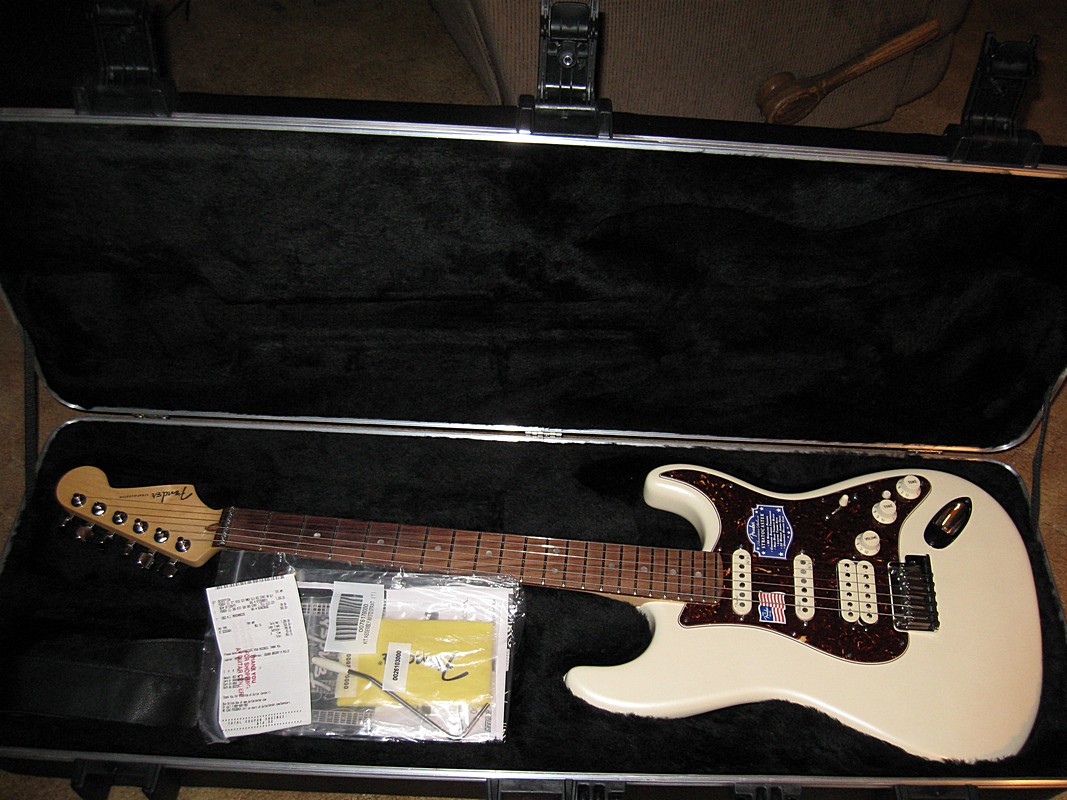
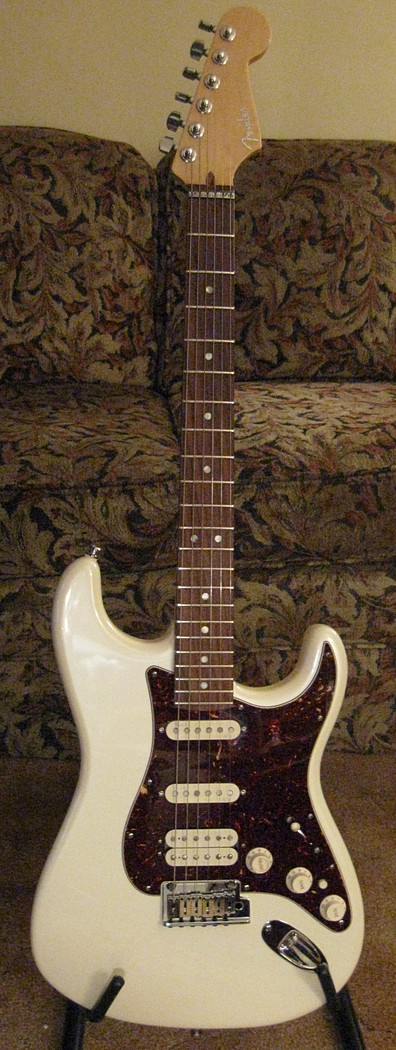
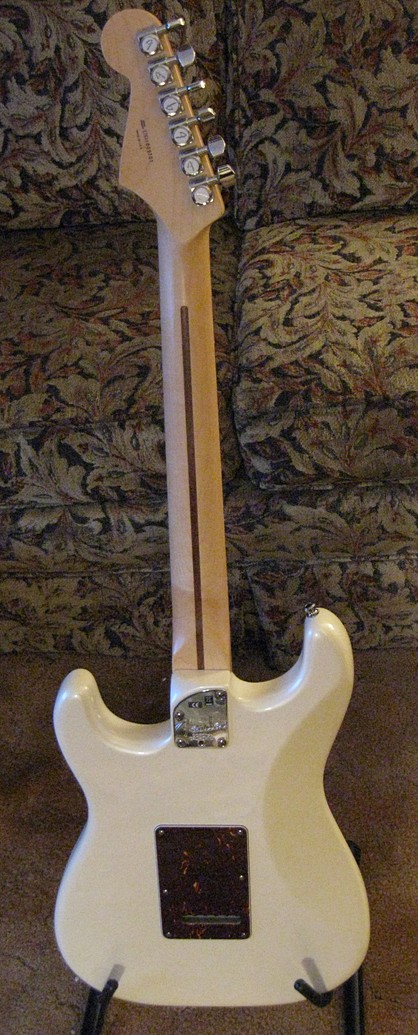
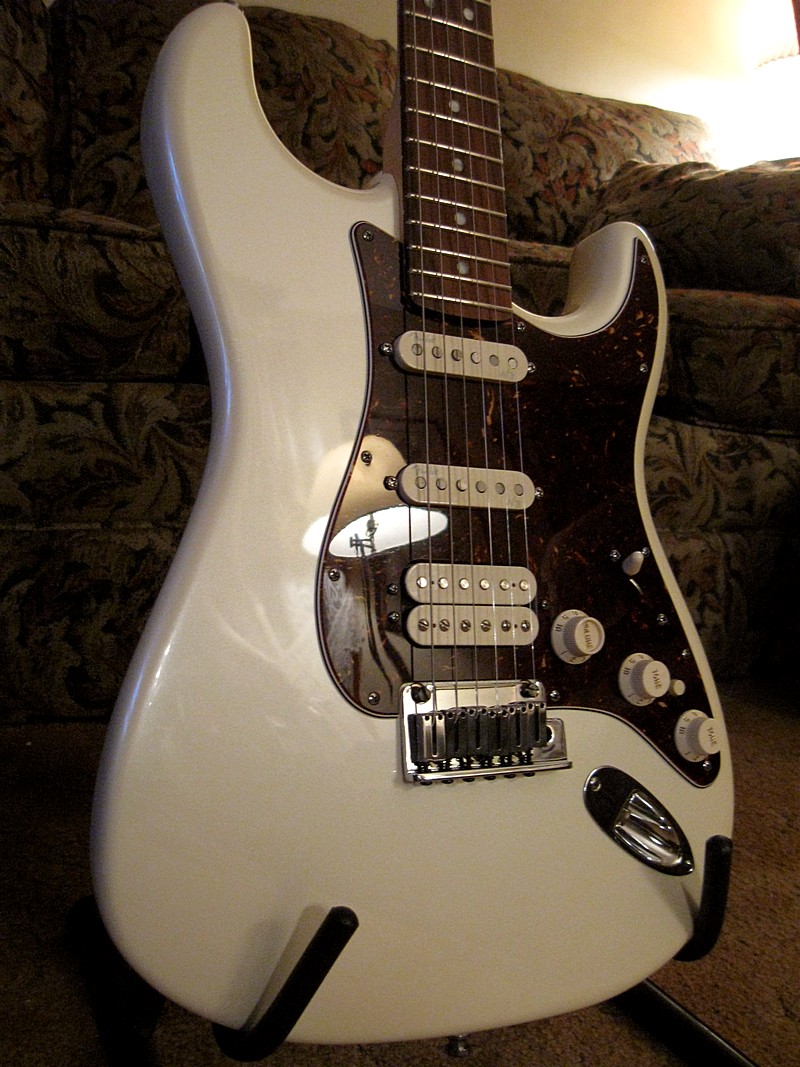
Here are a few songs that I recorded using this guitar with various different pickup selections, some of which aren't available on most Strats. Ibanez 6-string Bass GuitarBought this at Guitar Center in the early Summer of 2012 along with an Ampeg 250W 15" practice amp.
Here is a song example of the bass through my G-K 300/500W 2x12" amp... Walnut - 2/23/12 - 8/23/12Here are some recent (summer 2012) pictures of our new dog, Walnut. He is half border collie (mother) half sheltie (maybe) and is a bundle of energy and joy! 
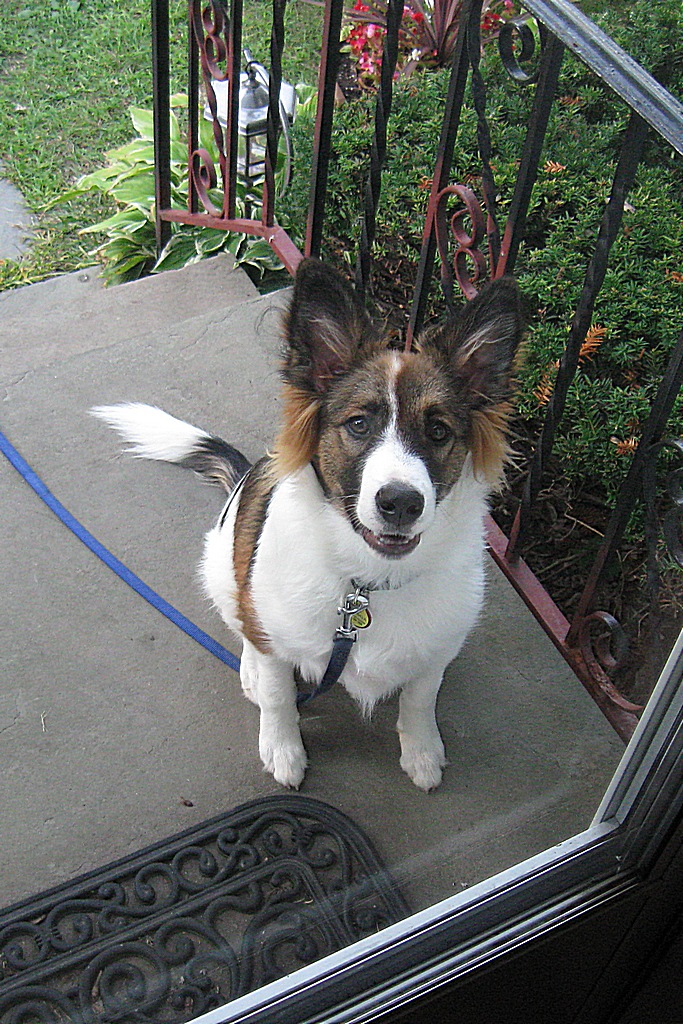


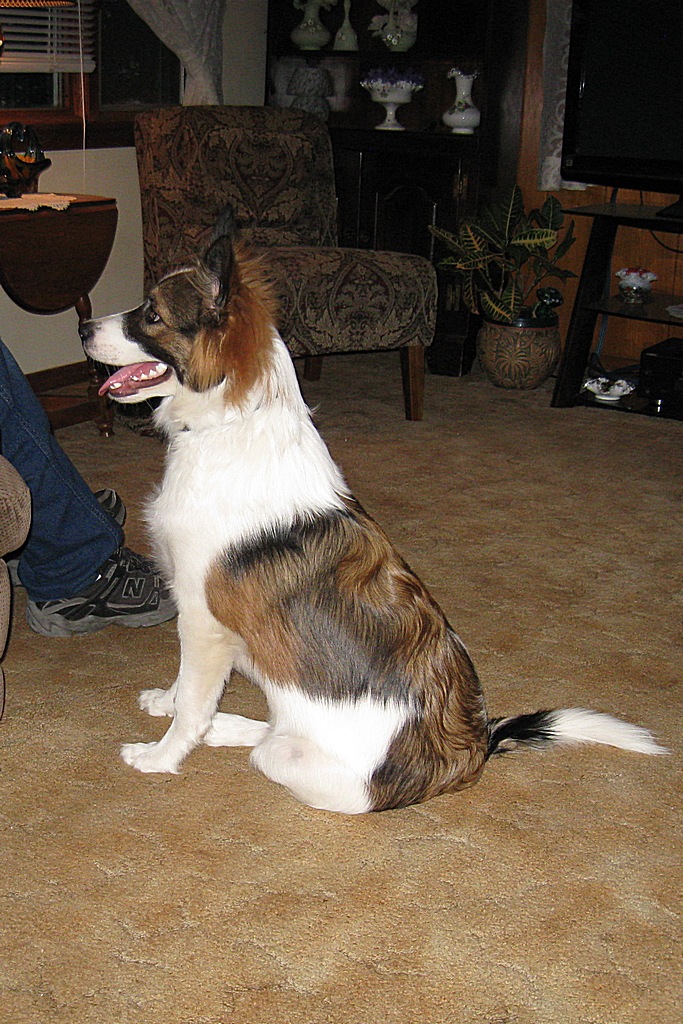
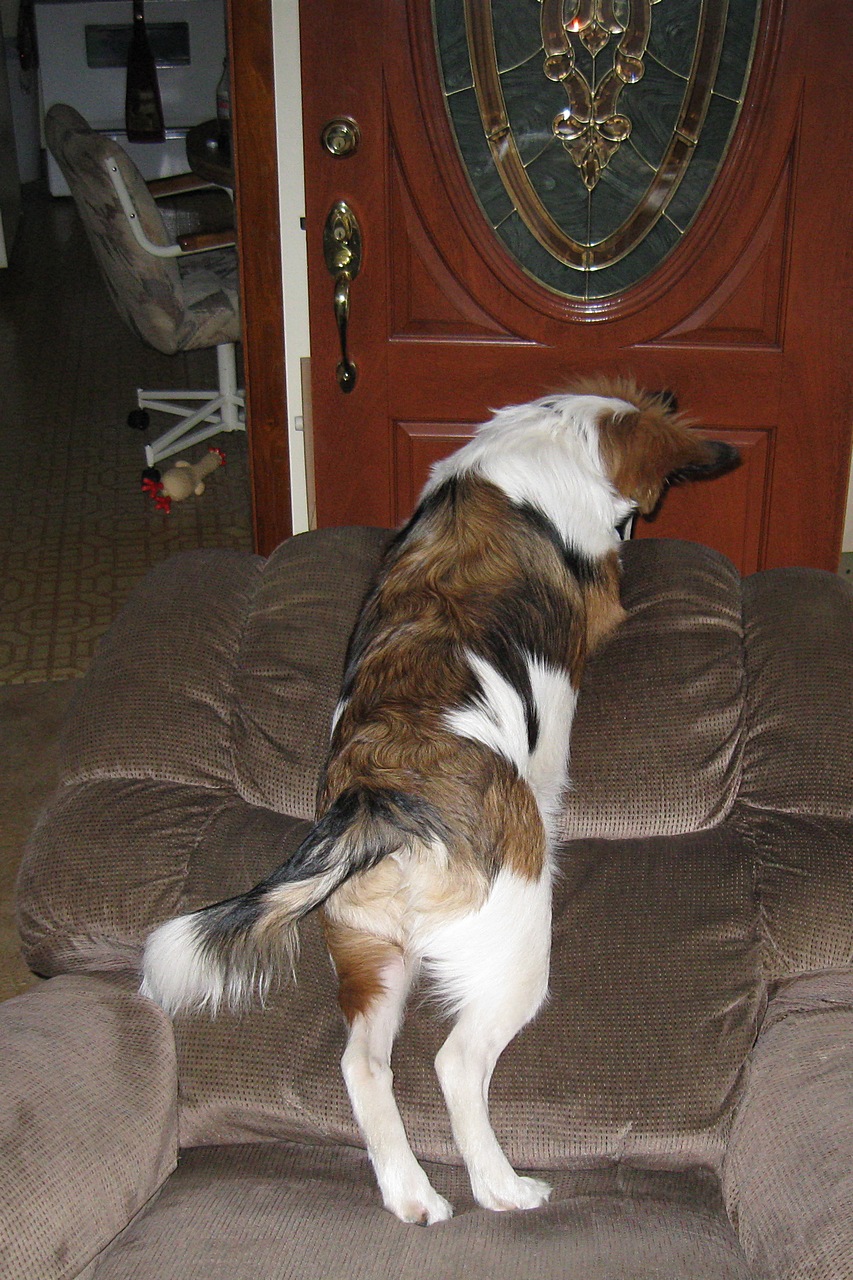



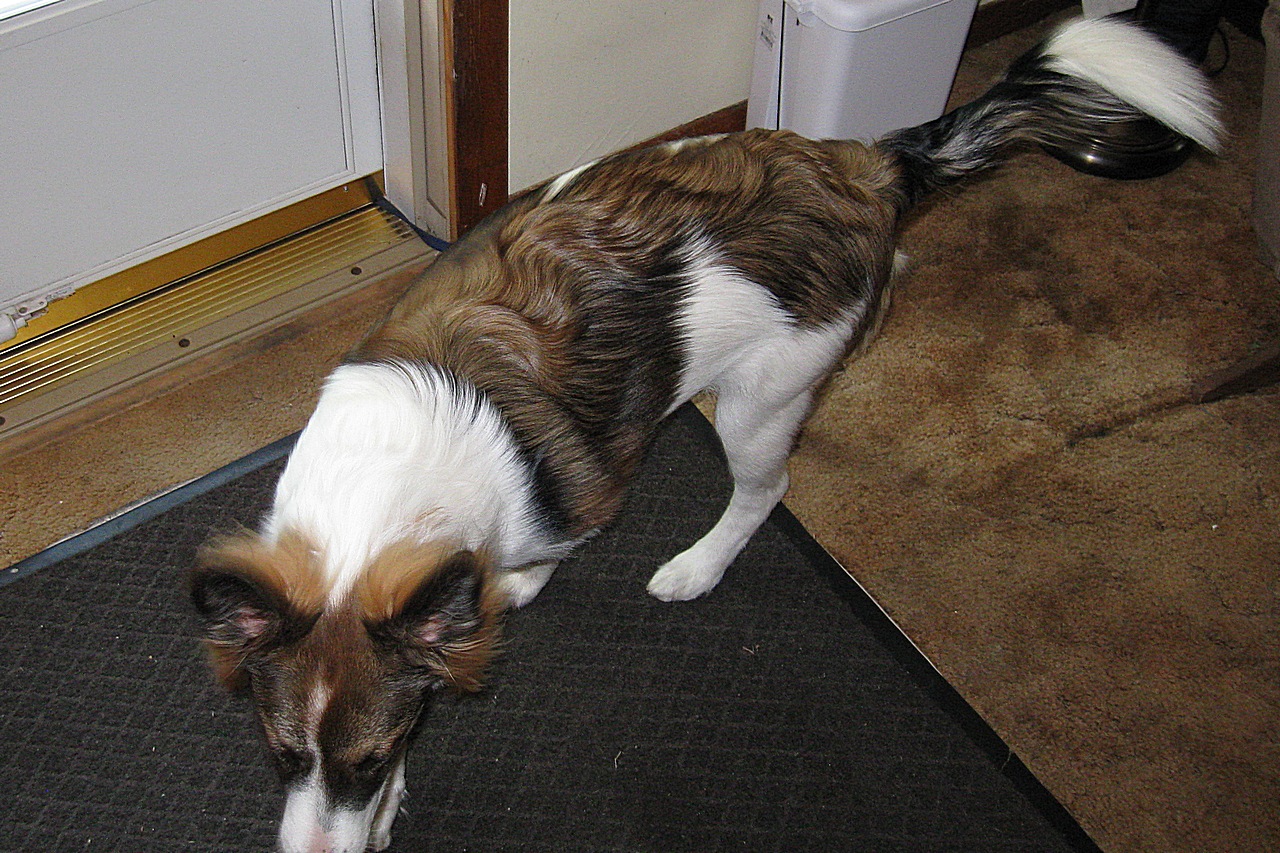

 He's long and sleek and fast, very fast! He weighs just over 40 lbs. at this stage in his development. His ears are very fuzzy and fluffy (and big).
P-Nutt passed away on Jan 19th, 2012 and Walnut arrived after Cinco De Mayo at the same exact age that we found P-nutt at (just 3 months earlier in
the calendar year... P-Nutt was born on 5/23/02).
He's long and sleek and fast, very fast! He weighs just over 40 lbs. at this stage in his development. His ears are very fuzzy and fluffy (and big).
P-Nutt passed away on Jan 19th, 2012 and Walnut arrived after Cinco De Mayo at the same exact age that we found P-nutt at (just 3 months earlier in
the calendar year... P-Nutt was born on 5/23/02).
More numerologically based similarities between P-Nutt and Walnut. Walnut was born on 2/23, P-Nutt on 5/23. Parents met and picked up Walnut on 5/5 and we got P-Nutt on 8/5... same exact age. And of course the names where dad named P-Nutt and Walnut already has his name. 1967 Gibson 12 string acoustic guitarI bought this guitar back around 1990 from a local guy who had it stored in an attic for a long time. He didn't know much about the guitar and neither did I at the time. What surprised me about the guitar was that the neck was in perfect shape and even though there are negative aspects to a tailpiece/bridge combo, the fact that the bridge didn't have the usual upward tension that pinned bridges do meant that this guitar didn't have the usual "bridge hump" that can ruin the action. Instead this guitar had a bit of a dip there but even with that dip the action was great, no buzzing strings and very easy to play. I ended up buying this guitar for $150 at the time. Now roughly 20 years later nothing has changed about the guitar in terms of string action and playability. I did remove the pickguard when I first got it because it was peeling off at the time. I still have the pickguard and may re-attach it someday because you can clearly see where it was due to the fact that the finish is slightly lighter in color in that area.Lately I've been trying to determine exactly which model this Gibson 12 string guitar is but can't seem to find an exact match. The serial number pressed into the back of the neck is "887606" which seems to indicate that this guitar was made in 1967 based on a serial number lookup table that I found. The body and design seem to be similar to the Gibson B25-12 model but there are some differences. The major difference is that my guitar has a 12/18 fretboard (12th fret at the body) and from what I read I'm pretty sure that all of the Gibson B25 models had a 14/20 fretboard, even the 3/4 sized model (and even if the 3/4 sized model did I couldn't find any indication of a 3/4 sized B25 12 string). Also, B25 Gibsons are said to have a black head and mine is natural wood. The back, sides and neck of my guitar are mahogany and the soundboard is spruce with an X-bracing configuration. The guitar has the original Kluson Deluxe tuners. The body binding on the back is just a single white strip while the body binding on the front, as well as the soundhole rosette both have a white/black/white pattern with the inner black/white sections each being half the thickness of the outer white stripe. One thing that I did notice about my guitar is that it looks like the bridge may have had some work in the past because there are "chisel" marks around it and I wouldn't be surprised if it isn't the original bridge or tailpiece for that matter (however it may be an improvement if the original bridge was a platic one common to some B25 models). I read that one advantage of the shorter neck was that it placed the bridge at a more optimal position on the soundboard. Here's a song that I wrote a while back for my steel string guitar and I just did a quick recording so I could post an example of the sound of my Gibson 12 string. I haven't played this song in quite some time so the performance is a bit rough in spots. I used a matched pair of condenser mics set about 18" apart so that one mic is just above the 12th fret and the other is just below the bridge. I added some reverb (maybe a bit too much) after recording. Click on the link below to download or play (the song has been compressed to a 256kbps MP3 file and is just under 6MB). 12 String Fury - 1967 Gibson For the record (or cassette, more accurately)...I have an old tape recording of me and Matt McNew (lead/rhythm/bg vocals + Rhythm/Lead/Lead Vocals)... never "restored/converted" to .wav.1998 Clemson TNT "Acoustic Competition" 2 rounds/nights (vocal mic'd -12string on 1st night's set, no pickup; borrowed a rhythm "sitting :Ovation" with heavy strings and a built-in pickup on 2nd night). Any tips regarding ripping from cassette tape to digital media? (Cool Edit Pro?) Below are some pictures (keep in mind that it has been a while since I last cleaned it)... UPDATE: I've gathered a bit more info regarding my 12 string guitar and I'm pretty certain that it is a B25-12 model guitar but still seems a bit rare considering that most B25-12 models have the 14/20 necks, not the 12/18 neck like mine. I did determine that the bridge has been replaced and the original bridge had pins (no tailpiece) because there is evidence of the sealed pin-holes when looking inside the guitar with a mirror. I'm not certain if the bridge repair was done at the factory by Gibson or not but somebody told me that it was common for this model to have the bridge replaced at the factory because the original bridge was prone to warping or pulling up on the soundboard. I must admit that the tailpiece style bridge seems to have extended the life of this guitar because the action has been superb for the 20+ years that I've owned it and it doesn't sound bad at all despite the criticism against this type of bridge configuration. I still wouldn't mind getting a bit more info on this guitar so If anybody can tell me exactly which model this Gibson acoustic 12 string guitar is, please let me know (my email can be found under the "About Me" section). I would also be curious to know how much this guitar might be worth but I don't have any plans of selling it because it plays great and I like the sound. UPDATE (2012): Via an email from someone who owns a similar guitar, with a lot more wisdom and years of research talking with the folks at Gibson... I found out and somewhat verified that my guitar is a "prototype" 1967 Gibson LG-12... (pin-bridge has, indeed, been replaced with a tailpiece combo). His LG-12 was not modified and in near-mint condition but the action looked "terrible" from the picture (hence the bridge upgrade on mine... action is phenomenal... never touched a thing on it except added an LR-Baggs Soundhole-type pickup... top of the line, same one that Dave Gilmour uses I'm told... cost $170 for a guitar that only cost my dad $150 in 1990!)... now it sounds better plugged in than it does acoustically (a huge surprise for me... never thought those soundhole pickups would work well considering that they work like an electric guitar pickup... but this one also reacts to vibrations in the soundboard similar to a standard piezo (under the saddle) pickup).... Anyhow, it seems that "his" prototype LG-12 was much closer to the actual LG-12 that was released soon after (natural finish as well... same materials however... spruce/mahogany). Not sure what mine is worth (don't really care or want to know... it might keep me from playing it!). Thanks for the help guys... especially the guy who sent me the email and shared his knowledge and pictures!!! I'll have to make a newer recording using the pickup and my Fishman acoustic amp someday... Ibanez Gio Mikro project (2011-2012)Found this guitar "used" for $80 (talked him down from $100 or so when I discovered that the bridge humbucker was faulty... dad rewired it as a single coil at first but that soon broke as well). 6 months later (approx)... and tons of hours of research, design and parts gathering I finally have it all together... sort of (not wired up yet). First I'll include the list of parts that I ended up with...Here's a picture of the semi-complete Ibanez Gio Mikro-Strat (air guitar)... I had tested it out with other pickguards and the sound is quite phenomenal... better than any new Strat that I've played under $1000... and sounds better than some that cost much more! I have a brand new American Deluxe Fender Stratocaster (with N3 noiseless pickups and a bridge humbucker) that sounds and plays great, except it actually sounds better though my Fishman acoustic amp than my Silvertone 50W 6L6 tube combo (w/Vox Tonelab LE effects) because I found that all of the "nuances" and "clarity" is lost with the electric setup... The Mikro-Strat is the opposite and really screams... can emulate SRV and Jimi extremely well... and since it is a shorter scale guitar (approx. 22"), you can really bend the notes much farther (where my regular strat will only bend about 2-3 steps, maximum, this Mikro-Strat is way too easy to bend notes as far as 4 steps!). It is a slight tribute to EVH, especailly considering that it is the only guitar that I can attempt to play the hammer-on, finger-tapping intro to "Hot For Teacher" without having my fingers ache in extreme pain from trying to reach so far! ...Hence the clear pickguard, and the red color... I suppose. Lots of time spent on this little guy, but it should be worth it in the end! 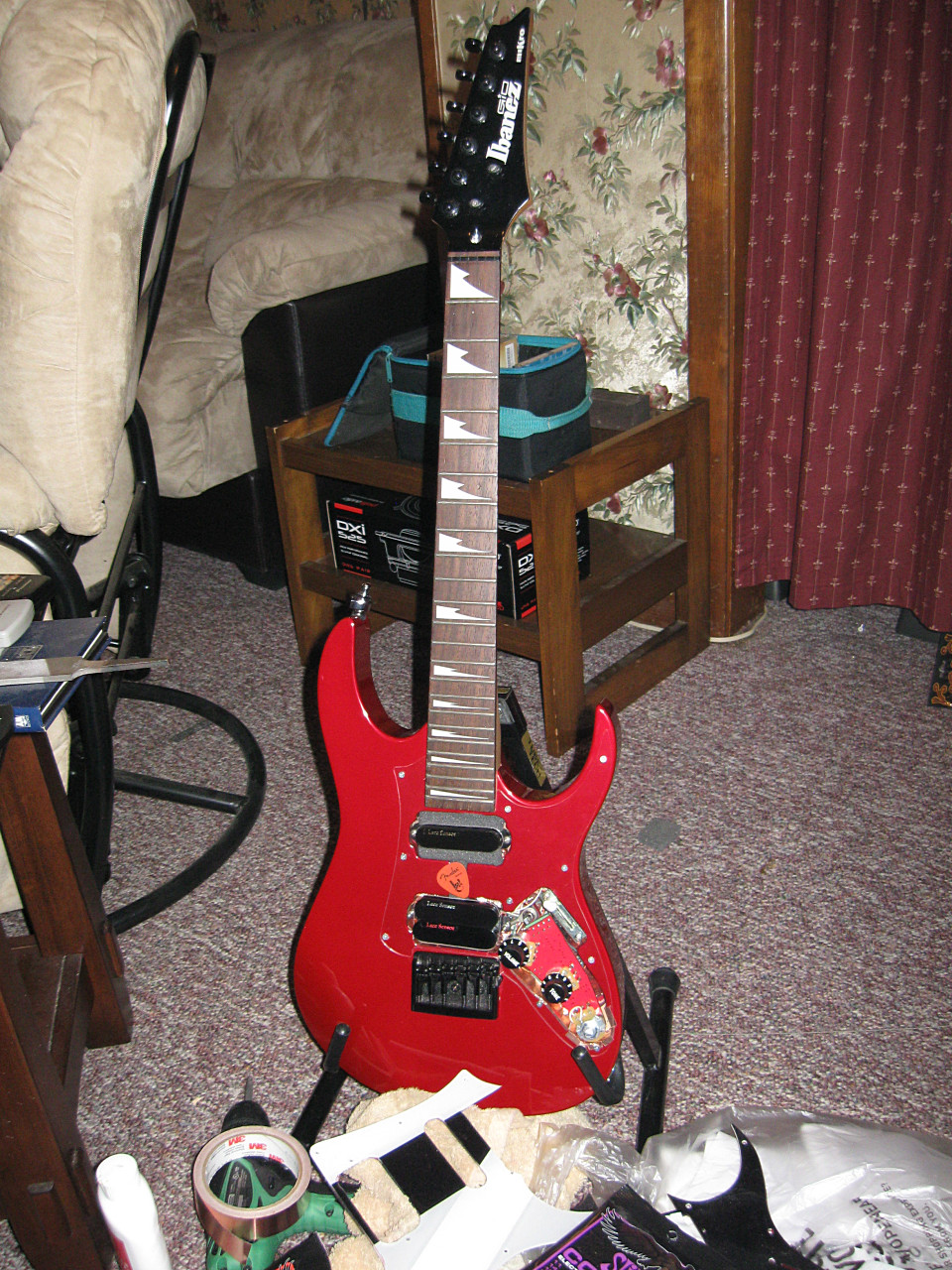
Next day bought a few extra accessories (new strap-$27, black knobs $4.99x2 for 4 knobs and a black Fender 5-way switch knob)... 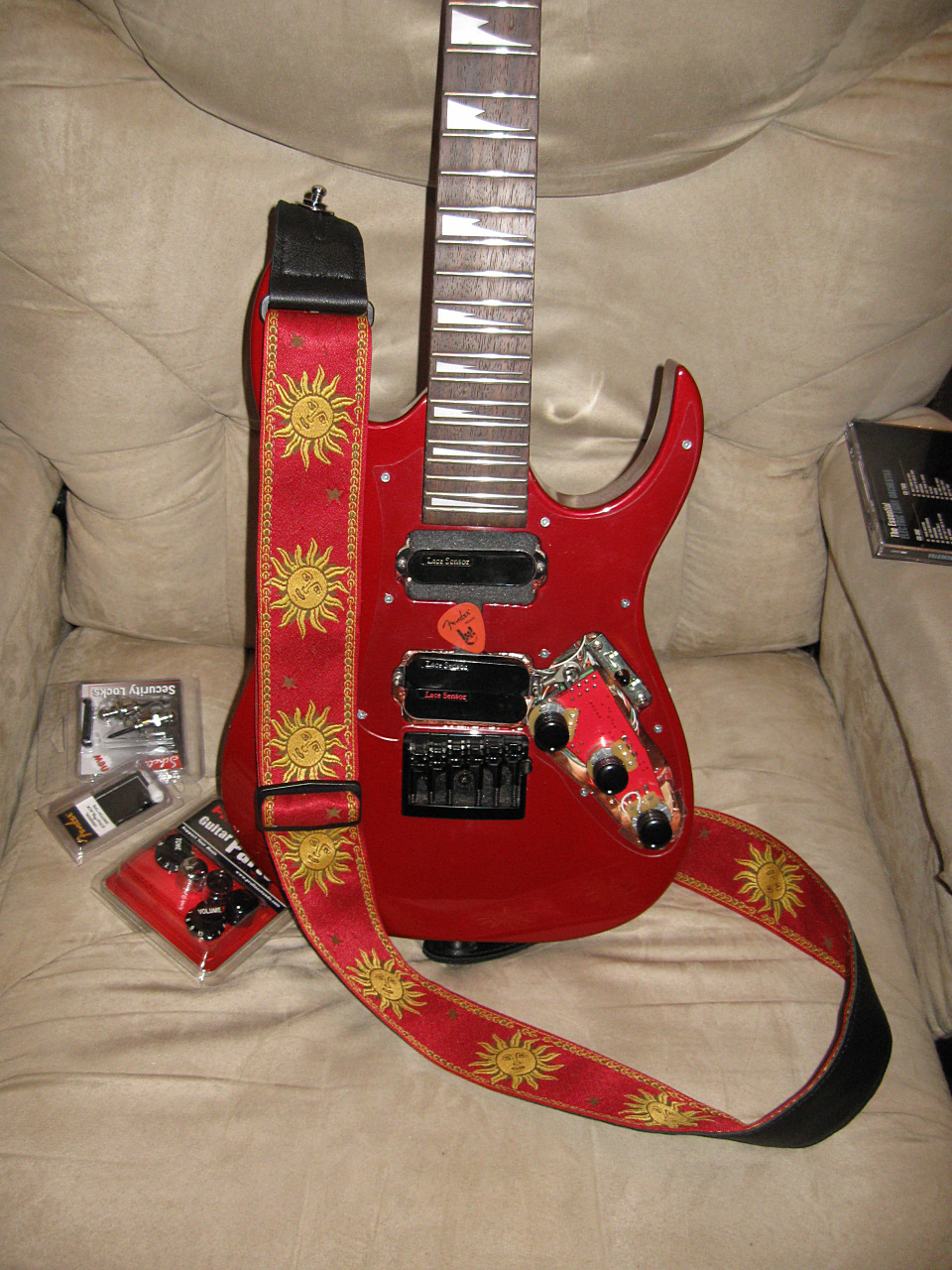
Here's a close-up of the new black knobs... set to "Z" (max. volume/tone/blend.... not 0-10 but A-Z, does it matter anyways!). BTW, the third potentiometer on the Toneshaper circuit is configured as a "blend" control rather than an additional "tone" control... The "blend" knob allows you to "add-in" the other pickup (bridge or neck pickup... depending on which pickups are selected by the 5-way switch. Ex. when the 5-way switch is set to the 4th position which activates the Silver and Red Lace Sensors, the "blend" knob allows you to add the Gold Lace Sensor... just like an extra Volume knob). This was the "best" option that I could find using the dip switches on the back of the Toneshaper circuit board and since I don't plan on changing any of those settings, I chose the most "versatile" option in my opinion. I also chose to set the "tone capacitor" to the smallest possible value so that it doesn't filter out as much of the high-end frequencies (treble) as most Strat tone controls... I may experiment further though, once I hook it all up... I'm still not sure if I want to go with the "Billy mod" option or not which alters the operation of the volume control and how it reacts regarding the tone of the pickups. 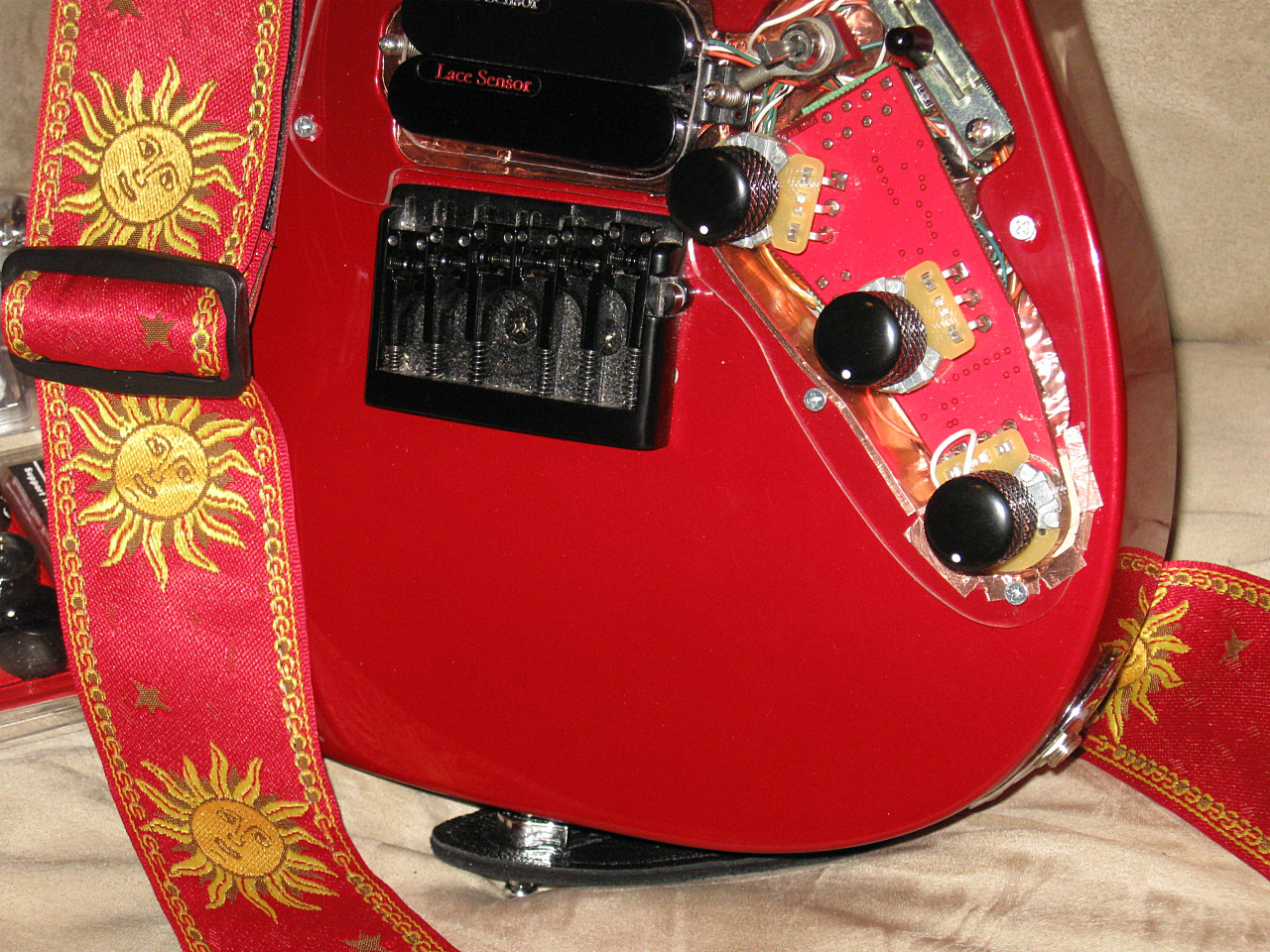
The only additional control that I added is the "silver" 3-way switch located between the volume control and the 5-way switch. This "silver" switch is used to select the phase configuration of the middle/Silver Lace Sensor... In-Phase/Off/Rev-Phase. I chose to do this because most Stratocasters use a middle pickup which is wound backwards (out-of-phase, relative to the others) in order to emulate a humbucking pickup when combined with the nearby bridge or neck pickup. However I may replace this "silver" switch with a nicer looking "black" toggle switch. I'm still figuring out how to "ground" everything to eliminate any possible hum and I don't plan on grounding the bridge considering that it is painted black and isn't conductive... and I don't like the fact that when certain guitars are set up this way you will get less hum by touching the strings (it makes me want to keep my one hand on the strings/bridge at all times to keep it quiet!) I must say that even though I've spent hundreds of hours on this guitar, I have learned so much in the process. While looking for parts/pickups a friend "donated" (gave it to me for free!) a Fender Squire Strat project that just needed a new set of bridge saddles and a bit of TLC/adjusting... which in turn, I gave to my best friend's stepson (once I got my Fender Deluxe Strat). There's a lot of stories hidden in this little guitar and I've made a lot of new (and old) friends in the process... I'm finding that I'm not only learning, but teaching others during this whole "project" which makes it all worthwhile! Right now it is still an "air guitar" even with strings on it, and I can't wait to have it all wired up so that I can play it and hear it "sing!" Update - MikroStratAfter experimenting with a thicker pickguard and phase switches for the silver and red pickups I decided to go back and make a new clear pickguard with no additional phase switches. I installed a Fender "roller nut" like my deluxe Strat above. I went back to the original "hole-through" bridge but added graphtek saddles. The tuners are the weak point due to their gear ratio. Would be nice to have a set of string-lock higher turn ratio tuners. Pickups sound great with the Toneshaper LE and I like the series/parallel option with the third control. This allows you to combine the neck/middle or middle/bridge pickups in parallel like a Gibson style electric (fuller, warmer tone). The other two controls are vol/tone of course. Here is an example recording using most of the pickup configurations from one to the next. MikroJam.mp3 Opinions, questions and/or comments welcome (email is under the "about me" section). |
